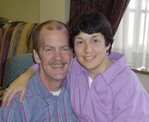
The crisp fall temperatures were perfect for camping. While on an afternoon hike, we’d already enjoyed the fall palette of colors God had splashed throughout the trees. Then the sun set, serenely washing the sky in pinks, oranges, and blues. Now a full harvest moon illuminated the night sky.
All the breathtaking imagery of a perfect October evening in Indiana was heightened as I glanced over at Bernie, tending the campfire in his cowboy hat, denim shirt, and jeans. Leisurely pouring himself a cup of coffee, he looked so different than the man I usually see in Tokyo, whose schedule finds him running from meeting to meeting, always clad in dress shirt, necktie, and suit, often pressured because the expectations are far greater than can possibly be accomplished by one man in one lifetime. Nevertheless, he tries, and the resulting tiredness often is as evident as his blue eyes and mustached upper lip. But I saw nothing of that this October night at the campfire. The “real” Bernie had returned and his satisfaction was as soothing as the hot cup of coffee he was soon sipping in silence.
Shortly afterwards, I met another blue-eyed, mustached gentleman. A generation older than my husband, he obviously suffered from Parkinson’s disease and the inevitable physical decline that comes with more than eight decades of life. Nevertheless, this descendent of Scandinavian forefathers had recently become the pastor of a church—not a fill-in, temporary until someone else could come, but the full-time leader. Granted, the flock he was shepherding was small, but helping people—no matter how many or how few—is never a small task. And at his age and condition? It was not the peaceful image of an evening around a campfire.
Neither was the toddler’s hand that grasped at the unyielding padlock which tightly held shut an old wooden door in a rural Indian village in August. No matter how her chubby little fingers worked at it, no matter how many times she tugged at it, the square silver lock obstinately refused to give in and open. Consequently, the door would remain closed to her.
But that’s as it should be. One cannot fault a padlock for doing its job. Yet I am haunted by that vision. The tiny, milk chocolate-colored hand on that lock paints the picture of the difficulty of sharing the good news of Jesus Christ in so many parts of the world, Japan included. Who will introduce the key to the uncompromising locks that bind so much of our world today? Jesus declared, “Here I am! I stand at the door and knock. If anyone hears my voice and opens the door, I will come in and eat with him, and he with me” (Revelation 3:20). But who would quickly open a door to a stranger? Not many people I know. Yet we would all warmly welcome our friends. I’d like to be that friend, bringing Jesus along with me as I visit. It can’t be left to eighty-something year-old people in ill health, no matter how willing they may be. Where are the others who will join me in this mission?






